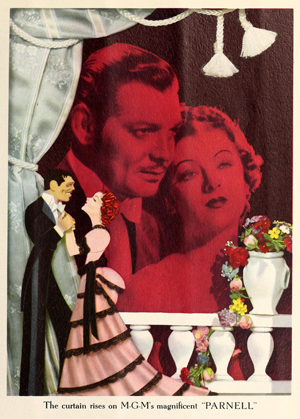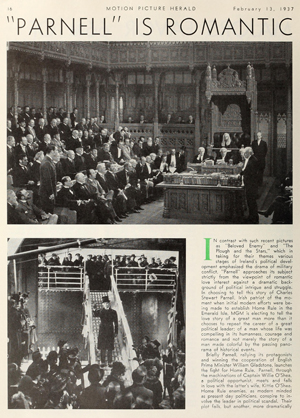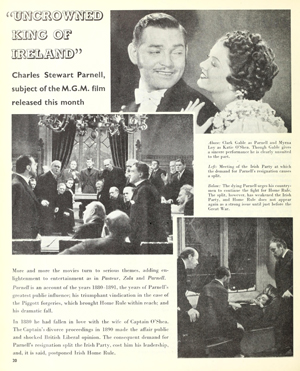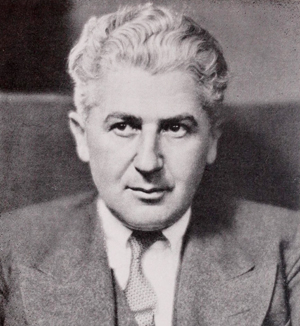Home Rule in Hollywood
Published in Features, Issue 5 (September/October 2019), Volume 27John Stahl’s Parnell (1937).
By Tony Tracy
Prior to Michael Collins (1996), one has to go back over half a century to find a Hollywood-funded drama dealing with an Irish political figure: the MGM production Parnell (1937), a lavishly produced bio-pic covering the period between Charles Stewart Parnell’s visit to the US in early 1880 and his death ‘in the arms’ of Katherine O’Shea in October 1891. Despite MGM’s characteristically extravagant costumes and sets, extensive historical research on the period and key figures and an all-star cast (including Clark Gable as Parnell), the film is today all but forgotten and largely unseen since its release. The recent centenary (of the release of his first film in 1918) of its equally overlooked director, John Stahl, has given rise, however, to a number of retrospectives and the publication of a collection of essays (the first) offering a reconsideration of this oddity of Irish-American film.

36 Above: What drew Clark Gable, the newly crowned ‘king of Hollywood’, to the complex and contentious drama of the ‘uncrowned king of Ireland’? (Film Daily, 10 February 1937 [New York])
The central involvement of star director Stahl, MGM mogul Louis B. Mayer and Gable in bringing the story of Charles Stewart Parnell to the big screen certainly seems incongruous at first sight. What drew two Russian Jewish immigrants—Mayer (born Lazar Meir in Ukraine) and Stahl (born Jacob Strelitsky in Azerbaijan)—and Gable, the newly crowned ‘king of Hollywood’, to the complex and contentious drama of the ‘uncrowned king of Ireland’? Hollywood’s motivation was, as ever, largely one of self-interest.
Parnell offered an opportunity for MGM both to take advantage of contemporary genre trends and to reinforce its status as the premier studio of Hollywood stars, spectacle and sentiment (in that order). On a more ideological level, Parnell provided an ideal—if somewhat surprising—vehicle for MGM/Hollywood to reassert its political bona fides during the ‘turbulent’ 1930s against a backdrop of Depression, racial intolerance and presidential patriarchy. Nevertheless, despite a lengthy and sophisticated PR campaign and the A-list experience and expertise of those involved, the film failed to realise commercial or critical expectations. It is its flaws rather than its flourishes that constitute its central interest today.
Parnell the play

Above: The film opens with Gable’s beardless and dashing Parnell (bottom) delivering an impassioned gangplank speech on Irish liberty in New York at the conclusion of his 1880 American tour. The opening section (top) concludes in the House of Commons with Parnell’s tactic of parliamentary filibustering. (Motion Picture Herald, 13 February 1937 [New York])
Despite being a rather conventional, stage-bound drama by a first-time author, Parnell was enthusiastically pursued by several Hollywood studios even before its Broadway opening. The MGM production files contain an effusive reader’s report:
‘A splendid play that offers excellent possibilities for the screen. The great, dramatic conflict between P’s love for his country and love for a woman is powerful and moving … The play will undoubtedly meet with favorable reception when it is presented on a stage. Recommended!’
Similar reports can be found from a number of other studios, leading to a bidding war, eventually won by MGM. Once on Broadway, however, the play drew mixed critical reaction, notably among Irish-Americans. James T. Farrell (author of the Studs Lonigan trilogy of novels) savaged it in his New Masses review, saying that while Parnell’s life story offered rich material for drama, the play failed because ‘the author, director and producers are all political illiterates … [resulting in] a love story borrowing the prestige of history [and] an inexcusable bore’. While the enormous resources of MGM sought to remedy—or at least disguise—such shortcomings through copious research and extravagantly authentic sets and costumes, the adaptation never fully escaped the limitations of its source material.
A bankable genre

Above: Parnell (Gable) and Katherine O’Shea (Myrna Loy); the Committee Room 15 meeting in Westminster at which the Irish Parliamentary Party splits in November 1890; Parnell (Gable) on his deathbed. (Film Daily Year Book, 1938 [New York])
[‘Uncrowned king’]
Such considerations help to explain not only the choice of material but also the adaptation process. In the stage production there were just three sets, emphasising the private over the public man: ‘Katherine O’Shea’s drawing room at Eltham’ for the first two acts, and ‘Gladstone’s study and Committee Room No. 15, Westminster’, for the third. Production files show that Charles E. Whittaker (1877–1953), an experienced Dublin-born screenwriter who specialised in adapting literary sources, was tasked with researching and drafting the screenplay, though a final version from August 1936 bears the name of English playwright John Van Druten. Between them, these writers sought to ‘open up’ the play by adding not only more locations but also more overtly political themes, particularly in the early scenes.
Thus the action begins not in Mrs O’Shea’s living room but on the New York harbour-front at the conclusion of Parnell’s victorious 1880 American tour (which took him through 60 cities and raised at least $350,000 for famine relief and the Land League). Surrounded by shouting crowds and marching bands, Gable’s beardless and dashing Parnell delivers an impassioned gangplank speech on Irish liberty. The action then moves to Queenstown, Co. Cork, followed by an encounter with an eviction in rural Ireland, a short spell inside Kilmainham Gaol and fevered debates set inside the British House of Commons.
Linked to the contemporary US social and political situation
Rooted in the historical context of nineteenth-century Irish nationalism, these scenes offer depth and pathos to our hero’s subsequent fall. But they can also be read as conspicuous efforts to link this history to the contemporary US social and political situation and find resonance in other Hollywood films of the time. Parnell’s defence of evicted Irish tenants echoes FDR’s description of ‘one-third of a nation’ in his second inaugural speech (1937), and the New Deal president’s commitment to speak for the ‘ill-housed, ill-clad, and ill-nourished’. Visually and thematically, the scene also finds an echo in John Ford’s evocation of disenfranchised Oklahoma dustbowl farmers in The grapes of wrath (1939), as well as other Ford films on the Irish struggle for independence from the same period: The informer (1935) and The plough and the stars (1936). Finally, the opening section concludes with Parnell’s tactic of parliamentary filibustering, which would find a comparable New Deal echo in Frank Capra’s populist Mr Smith goes to Washington (1939).
The writers of Parnell did not seek simply to find contemporary resonances for the action but also sought to offer greater historical depth and texture to the story, notably through extensively researched attention to the Piggott forgeries affair and its fallout. Nevertheless, while the screenplay is surprisingly faithful to the details of this episode, it simplifies and excludes much of the bitterness of public opinion, the Catholic Church and the British and Irish press at the time. Such simplification can be directly traced to Joseph Breen, Hollywood’s censor, a devout Irish-American Catholic (and recent visitor to Ireland) who had sought to dissuade several Hollywood producers from adapting the material in the first place. In a 1935 letter to Mayer, Breen wrote:
‘The whole question of Parnell is a very delicate question … The Irish, in this country and in Ireland, are likely to resent any aspersion cast on the memory of a man who is generally believed to be one of the greatest of Irish Statesmen and patriots. The English are certain to take umbrage at the portraiture of Gladstone. It is our recommendation that you continue to think a little more about the purchase of this play for screen presentation.’
Thus, in the aftermath of the action described above, the film draws in its political themes and shifts its emphasis from politics to Victorian mores and social relations: from Home Rule to home rules. We have no mention, therefore, of Katherine O’Shea’s children—three with her husband and three with Parnell (two of whom survived). Breen also insisted that ‘scenes showing physical contact between P and Katie be reduced to an absolutely necessary minimum’, and that the writers should ‘omit embraces in 3 scenes’ and ‘Drop any use of God’, etc. Through subsequent rewrites the script was gradually shorn of its political and cultural specificities, as well as of the fascinating complexities of its central romantic narrative.
Anglo-Irish history on a grand scale
Filmed on over 70 separate sets designed by Cedric Gibbons, with costumes by Adrian and cinematography by Karl Freund, Parnell envisions Anglo-Irish history on a grand scale. But despite a clear and well-resourced commitment to circumstantial veracity—personalities, events, settings and décor—its two lines of drama become muted and largely sentimental. Home Rule becomes a democratic ideal for which Parnell is admired and even, to an extent, supported by Gladstone and his fellow parlimentarians and in which he might have succeeded were it not for the oppressive taint of scandal and the narcissistic greed of Captain O’Shea, the only true villain of the piece. Spite and venality—rather than Britsh politics or Irish Catholicism—quash the Capraesque ambitions of Stahl’s protagonist.
While Parnell thrives in political settings, Stahl establishes him as a character for whom Home Rule has a double sense, political and private, with the latter ultimately more significant and rewarding. Mirroring the earlier eviction scene in Ireland, he is first invited to the O’Sheas’ comfortable Home Counties home by Katie on behalf of her estranged husband, who seeks to make progress in Irish politics. Parnell moves into the house soon afterwards on Katie’s insistence as a result of nervous exhaustion, creating a scandal and sowing the seeds of his eventual downfall. As Stahl tells it, home is where the (weak) heart is— counterpointing emotional fulfilment with public opprobrium. While this is a not uncommon conjunction in the Hollywood family melodrama, it is a highly unusual approach in the male political bio-pic.

Above: Director John M. Stahl. Recently fired from the financially troubled Universal Studios, Parnell offered him an opportunity to return to the romantic themes and melodramatic mode that established his reputation during the silent era of the 1920s. (World Film News, November 1937 [London])
These factors, taken together, suggest that Parnell tells us more about Hollywood history than Irish history. Its strengths and shortcomings serve nonetheless to stimulate reflection and discussion about a historical figure and moment that are increasingly remote and reminds us of the value, as well as the productive complexities, of telling and retelling history through drama and moving images. The rise and fall of Parnell remains a ripe and unrealised subject for an indigenously produced film or mini-series.
Tony Tracy is Director of the Huston School of Film and Digital Media, NUI Galway.
FURTHER READING
B. Babington & C. Barr (eds), The call of the heart: John M. Stahl and Hollywood melodrama (Bloomington, 2018).
















